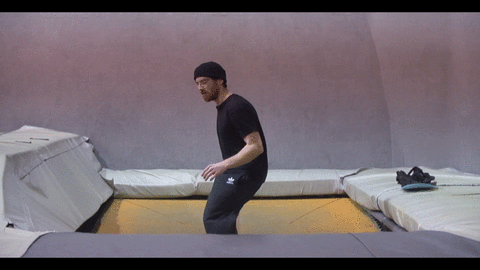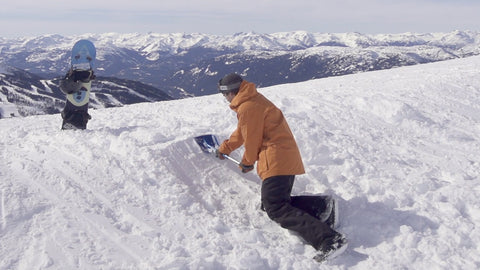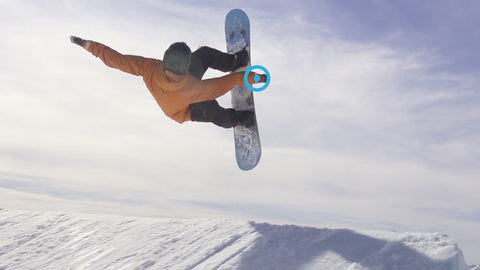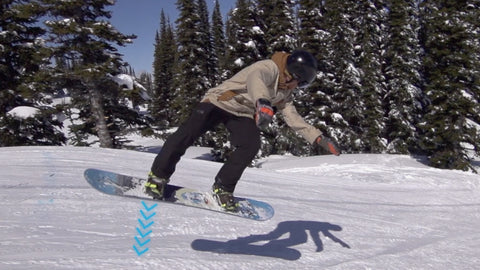
How To Wildcat
Wildcats are the ideal starting off point for those aspiring to Backflip. Why you might ask;
- You can start on small features
- Adding grabs will help you keep it clean, and
- Most importantly, they're a lot of fun to do 🤙
For more flips, check out our entire Flips & Off Axis series.
(Narrating: Nev Lapwood. Riding: Chase Baines. Filming/Editing: Vince Emond. Filmed At: Whistler Blackcomb & Whistler Bounce)
Trampoline
Practicing on a trampoline is a great way to start learning a Wildcat as you can stomp the trick almost as many times as the gif below.
On the tramp you will build your Wildcat muscle memory, timing, spacial awareness and when to spot your landing. The Tramp Board replicates the weight and feel of a snowboard and will improve your odds of stomping your Wildcat first go on the snow.

Getting a feel for Wildcat Style Flips on the tramp
You can also use the tramp to understand how much you need to tuck in as you rotate and how to speed up and slow down your rotation.
Building The Jump
Wildcats are great because they are so achievable on small features, which also means you can practice them just about anywhere. Pack down a little booter with a kicky lip and you're good to go!

Building the perfect lip to set you up for success.
Approach & Take Off
You want to approach the feature with a completely flat base and your shoulders aligned over the nose and tail of your board. Keep your back arm raised and the angle of your upper body matched with the lip of the jump. This positioning will help set up the rotation even before you pop off the jump.
As you approach the lip of the jump, lean your body over the tail of your board, press up and back with your legs, throwing that back arm down and lifting your front arm up. Pop off the lip as you initiate your flip.
 Use your arms to initiate spin off the lip of the feature
Use your arms to initiate spin off the lip of the feature
If your shoulders are in proper alignment with the nose and tail of your board, your forearm will be a great point of reference of where to look through the rotation. When you throw your arms and tilt your shoulders towards the tail, your line of sight should follow your lead arm upwards and around.
 Holding line of sight with your lead arm through the flip.
Holding line of sight with your lead arm through the flip.
Grab It
When you take off, tuck in and grab Indy. This is the easiest grab for a Wildcat and helps you stay tight and aligned throughout the rotation.

Who wouldn't want to add this grab in?
*Be careful though, adding in an Indy grab will speed up your rotation and over rotating means landing heavy on your tail.
Landing
Spotting the direct point of landing on a Wildcat can be difficult. Instead, focus on where you are in relation to the ground. Air awareness and timing is everything which is where trampoline practice can really help you in getting comfortable with flips.
When you start spotting the ground, this is your cue to release your Indy grab and extend your legs accordingly. Push your back foot out slightly when you land so the tail of your board can absorb most of your landing.

Absorbing the impact with the tail of the board.
This landing technique will also be critical when you're throwing this trick down on deep days into a pow landing. Once you feel confident on small features, you can start experimenting with Wildcats on bigger jumps and adding in different grabs.
3 Key Tips To Remember:
1. The feature you try this on is important. "Lippy" jumps that send you higher rather than further are better.
2. Alignment of your shoulders during your wildcat is key. If you start to loose your shoulder alignment, you could end up corking it unintentionally which never ends well. Keep your shoulders aligned with your board throughout the flip.
3. Look where you're going. Don't leave your head behind during your flip. Keep your eyes tracking up to the sky, then around to the landing.
Well what are you waiting for?
Get 6 Free Flipping Tutorials For Free:
Hannah Paquette
Snowboard Addiction
Our Goal Is To Improve Your Riding



 Use your arms to initiate spin off the lip of the feature
Use your arms to initiate spin off the lip of the feature Holding line of sight with your lead arm through the flip.
Holding line of sight with your lead arm through the flip.
